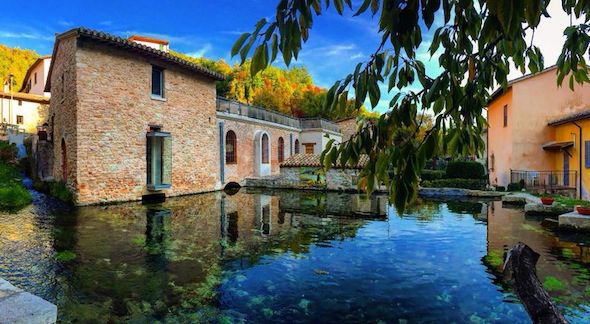Il borgo di Rasiglia è un luogo incantevole, dove ritrovare quell’atmosfera dimenticata delle piccole cose antiche. Tra le case in pietra e le piazzette, il paesino è attraversato da strette stradine alternate a ponticelli in legno, ruscelli e cascate.
In questo scenario unico potrete passeggiare immersi nella natura e cullati dallo scrosciare delle acque, alla scoperta degli scorci più pittoreschi.
Passeggiare a Rasiglia
E’ difficile descrivere a parole Rasiglia, si tratta di un luogo da ammirare con i propri occhi e ascoltare con le proprie orecchie.
Il borgo è molto piccolo, una cinquantina circa di casette in pietra adagiate al fianco della collina sovrastante come a formare un anfiteatro naturale, immerse nei boschi e attraversate da stradine e ruscelli di acqua purissima. La acque del borgo sono alimentate infatti dalle sorgenti del fiume Menotre, che nasce proprio in questi luoghi incontaminati.
Girovagate tra le strette vie e lasciatevi guidare dal suono armonioso dei canali che scorrono tra le case, per poi allargarsi e in più punti formare dei bellissimi laghetti.
Il borgo è molto antico, i primi documenti che testimoniano l’esistenza di un insediamento risalgono agli inizi del XIII secolo. La fortuna del luogo fu probabilmente dovuta alla via della Spina, importante via del commercio tra la costa adriatica e la città di Roma che attraversava il territorio proprio nelle vicinanze.
In seguito l’importanza strategia e militare del luogo diminuì, ma Rasiglia e i suoi abitanti furono capaci di re-inventarsi come realtà rurale. Qui fiorirono infatti varie attività contadine e artigianali legate al lavoro della terra, facilitate senza dubbio dalla presenza delle sorgenti e dunque della forza idrica del fiume nascente, decisiva nello sviluppo di mulini, opifici e tintorie che lavoravano stoffe pregiate.
Rasiglia e il borgo: cosa vedere
Se è vero che ruscelli e laghetti catturano l’attenzione durante la visita, ci sono anche altri piccoli particolari da non perdere a Rasiglia legati proprio alla storia e alla vocazione rurale e artigiana del borgo.
Gli antichi mestieri del borgo
In primis, l’antico mulino: tra le attività aperte, una bottega si trova all’interno dell’edificio di un mulino ristrutturato. Entrate per curiosare tra gli oggetti artigianali esposti e approfittate per ammirare l’antica macina del mulino stesso, ancora collocata al suo posto.
Il lavatoio del paese è oggi completamente restaurato nel rispetto della sua antica funzione e arricchito da una stampa d’epoca collocata proprio al di sopra della vasca. Rende perfettamente l’idea del suo utilizzo in passato e dell’importanza centrale che aveva per lo sviluppo tessile locale, assieme alle sale dove si tingevano e lavoravano i tessuti.
Tanto è stato centrale il settore per il borgo che da alcuni anni gli abitanti collaborano per svolgere in giugno “Penelope a Rasiglia”. La manifestazione è incentrata sulla tessitura e prevede la rievocazione di alcune attività tipiche del passato, come la tosatura delle pecore, la tintura della lana o il laboratorio di tessitura antica.
Passeggiata ai resti del Castello
Per chi voglia concedersi una passeggiata un pochino più impegnativa, consigliamo di prendere il sentiero che sale ai resti del Castello di Rasiglia. La struttura è situata sul colle che sovrasta il paese e in passato presentava una forma irregolare che ben adattava alle caratteristiche stesse del colle. Aveva una funzione principalmente di difesa, ma anche di residenza nobiliare per la famiglia Trinci di Foligno, che tra il XIV e il XV secolo fece costruire numerosi castelli e fortificazioni nella zona.
Nel 2006 sono stati avviati dei lavori di ristrutturazione e ad oggi è i resti del castello sono costituiti da un tratto di mura con torri difensive e il rudere del mastio principale.
Rasiglia: presepe natalizio
Segnaliamo un momento particolarmente suggestivo per visitare Rasiglia: ogni anno infatti nel periodo natalizio si organizza “Rasiglia Paese Presepe”, generalmente nel giorno di Santo Stefano il 26 Dicembre e dell’Epifania il 6 Gennaio.
Il borgo si anima interamente e torna a vivere nel passato, con il presepe vivente allestito dagli abitanti che si prestano a figuranti in costume d’epoca e aprono le proprie case ai turisti, dove vengono ricostruite scene di vita quotidiana o di lavoro del passato. Tessitori, tintori, fabbri, calzolai e speziali rivivono nel borgo e offrono un’esperienza davvero autentica.
Dunque, come arrivare a Rasiglia?
Chi ci è stato la chiama la “piccola Venezia umbra”, per i caratteristici canali che la attraversano rendendola unica. Eppure sono in tanti anche tra i residenti a non conoscere ancora questo angolo di paradiso. Dove si trova allora Rasiglia?
Il borgo fa parte del comprensorio di Foligno ed è situato a circa 20 km dalla città. Se provenite da Foligno, proseguite lungo la SS77 che conduce verso Colfiorito per poi deviate lungo la SS 219 Sellanese che si distacca dalla prima a Casenove per scendere verso la Valnerina.
Appena un paio di km dopo aver superato Casenove, sulla sinistra appariranno all’improvviso le casette che delimitano Rasiglia. Purtroppo gli spazi sono limitati e i parcheggi pochissimi, generalmente i visitatori lasciano le proprie vetture lungo la strada principale che costeggia il paese stesso. Segnaliamo comunque un parcheggio disponibile sulla sinistra per chi viene da Foligno, appena superato l’incrocio principale del paese.
Vi accoglieranno le targhe di “Rasiglia e le sue sorgenti” e di una poesia in omaggio al borgo: da qui potrete avviarvi al suo interno, passeggiando liberamente e ammirando i tanti particolari che decorano e valorizzano il luogo.



Comment (0)